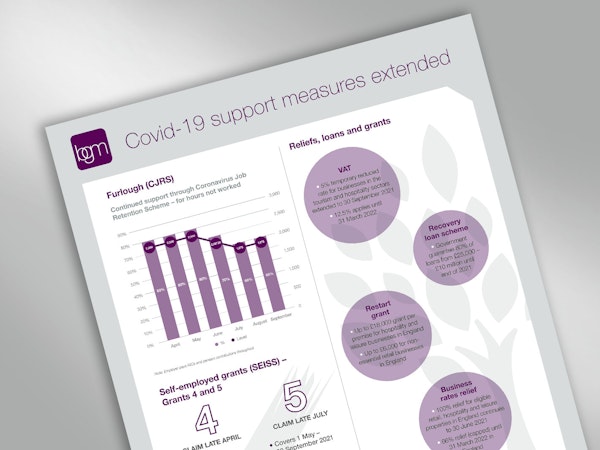Coronavirus Job Retention Scheme – Update
Coronavirus Job Retention Scheme (Furlough leave)
- This scheme is to help employers to continue paying part of the salary for those employees that might otherwise have been laid off during this crisis.
- HMRC are currently setting up a new online service through which employers will be able to make a claim. This is expected to be available before the end of April 2020.
- This scheme will be open to all UK employers who
- Had a PAYE scheme operating on 28 February 2020.
- Have enrolled for PAYE online, and
- Have a UK bank account
- After a claim is submitted a taxable grant will be paid directly to the employer’s bank account.
- The grant will start on the date that the employee stopped work and is furloughed. (For example if employees worked as normal to 31 March then the start date will be 1 April 2020.)
- This is a temporary scheme in place for 3 months starting from 1 March 2020, but it may be extended if necessary and employers can use this scheme anytime during this period. The claims can be backdated to 1 March where employees have already been furloughed.
How to claim the grant
- An employer will only be able to make a claim once the staff to be furloughed have been agreed on, their amended contracts agreed and they have stopped working for the employer.
- Employers should make the claim either shortly before or at the same time as running the payroll.
- The Government has published this list of information that the employer will need to make a claim:
- The ePAYE reference number
- The number of employees being furloughed
- The claim period (start and end date)
- The amount claimed (per the minimum length of furloughing of 3 consecutive weeks)
- Employer’s bank account and sort code
- A contact name
- A contact phone number
- HMRC will have the right to retrospectively audit claims. Employers should therefore retain their calculations used to make the claim.
How much can be claimed
- The maximum grant that HMRC will pay to employers will be calculated as the lower of:
- 80% of an employee’s “usual monthly wage cost” and
- £2,500 per month
Plus the associated employers’ national insurance contributions (NIC) on this amount and the minimum automatic enrolment employer pension contributions on that wage.
- There has been a change to the definition of “usual monthly wage” from the original announcement. This can now include any regular payments that the employer is obliged to pay (which could include overtime already worked & compulsory commission payments).
- Discretionary fees, commission and bonuses and salary sacrificed should not be included, nor should non cash benefits in kind.
- Employers and employees can agree to amend employment contracts to cancel or change a salary sacrifice. Covid-19 counts as a “life event” that allows changes.
- For full time or part time employees their actual salary before tax at 28 February 2020 should be used to calculate the 80%.
- For employees whose pay varies
- If they have been employed for a full 12 months prior to the claim the employer can claim the higher of:
- The same month’s earnings from the previous year
- Average monthly earnings from 2019/20 tax year (i.e. 6.4.2019 to 5.4.2020)
- If the employee has been employed for less than a year the employer can claim for an average of their monthly earnings since they started work.
- If they have been employed for a full 12 months prior to the claim the employer can claim the higher of:
- If the employee only started in February 2020, the employer can calculate the claim based on a pro-rata of their earnings so far.
- The employer will pay the employee, the amount agreed under the employment contract, through the payroll using the RTI system as usual. This must be at least equal to the amount of the grant claimed, i.e. the lower of 80% or £2,500 per month.
- The National Living Wage and National Minimum wage only apply for hours worked and do not apply while an employee is furloughed. These rules do apply if an employee or apprentice is required to undertake training while on furlough.
- The employer can choose whether to make up the balance of the salary but does not have to. This is a matter of employment law and subject to any agreed amendment to employment contracts.
- The grant under this scheme will form part of the employer’s taxable business income. The payments to employees will be tax deductible as usual. (This is uncertain for domestic staff.)
Employees that an employer can furlough and claim for
- Furloughed employees must not work for the employer during the period they are furloughed. This includes providing services to or generating revenue for the employer.
- Employers can make a claim for any employee who was on the payroll on 28 February 2020 who has been furloughed.
- Employees hired after 28 February 2020 cannot be furloughed and claimed for in accordance with this scheme.
- Furloughed employees can be on any type of contract, including:
- Full time or part time,
- Employees on flexible or zero-hour contracts.
- Apprentices
- Employees on fixed term contracts.
- Domestic employees
- The scheme also covers employees who were made redundant after 28 February 2020, or left for any other reason, if they were on the payroll at 28 February and have been rehired by their employer.
- Employees receiving statutory sick pay cannot be furloughed, but they can be furloughed and claimed for once they are no longer receiving Statutory Sick Pay.
- The following individuals who are not employees under employment law but are paid under PAYE through the payroll can also be furloughed and claimed for (providing that the furlough arrangements are formally agreed as a decision by the company or LLP in accordance with company or partnership law as appropriate):
- Office holders including company directors
- Salaried members of LLPs – who are designated as employees by the legislation in ITTOIA 2005 and paid under PAYE.
- Agency workers (including where employed by umbrella companies) – the furlough should be agreed between the agency, as the deemed employer, and the worker.
- The agency worker should not do any work for the agency or any of the agency’s clients while furloughed.
- Limb (b) workers – for example a gig worker with a platform or a dependent contractor who is paid under PAYE (and not self-employed for income tax purposes) can be furloughed.
- Contingent workers in the public sector (including off-payroll workers supplying services through a personal service company).
- An employee must remain on furlough for a minimum period of three weeks, although a further period may immediately follow the previous furlough if agreed. This will depend on their employment contract.
- A furloughed employee can do volunteer work, training, or get another job providing they do nothing for the employer claiming under this scheme.
- Furlough leave will be a change of status for employees and employers will need to notify the employees of this change in writing and discuss it with them.
- The furlough leave will be subject to existing employment law and the employment contract, the terms of which may affect the implementation of furlough leave.
- We recommend that employers seek legal advice when furloughing employees.
We will continue to monitor Government announcements and provide updates as the situation evolves over email, on our website, LinkedIn and Twitter account.
Please contact your BGM advisor or email communications@bgm.co.uk if you would like any assistance.




